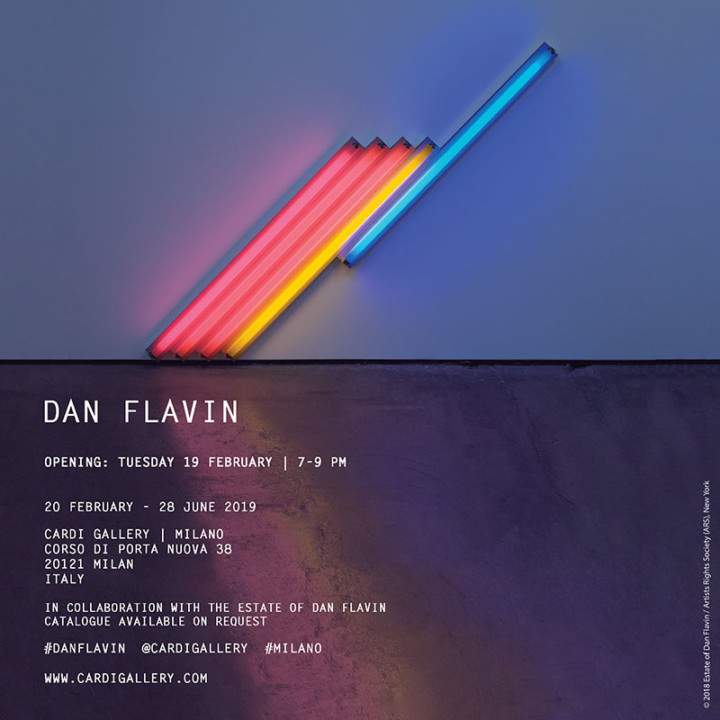Milan, an exhibition dedicated to Dan Flavin at Cardi Gallery
Galleria Cardi in Milan is pleased to present, from February 19 to June 28, 2019, a retrospective of the great American minimalist artist Dan Flavin (New York, 1933 - 1966). The exhibition is organized in collaboration with the Dan Flavin Estate and is accompanied by an illustrated catalog that includes an essay by esteemed art critic Germano Celant.
Dan Flavin is internationally recognized for his installations and sculptural works made exclusively with commercially available fluorescent lamps. The exhibition at Cardi Gallery in Milan will present fourteen light works from the late 1960s to the 1990s that show the evolution of more than four decades of the artist’s research into notions of color, light and sculptural space.
In the summer of 1961, while working as a guard at theAmerican Museum of Natural History in New York, Flavin began making sketches for sculptures that incorporated electric lights. Later that year, he translated his sketches into assemblages, which he called “icons,” that juxtaposed lights with Masonite constructions painted one color. In 1963, he removed the rectangular stand completely and began working with his fluorescent lamps. In 1968, Flavin expanded his sculptures to room-sized spaces and filled an entire gallery with ultraviolet light at Documenta 4, Kassel (1968).
Flavin always emphatically denied that his sculptural light installations had any kind of transcendent, symbolic or sublime dimension, stating, “It is what it is and it is nothing else.” He claimed that his works were simply fluorescent light responding to a specific architectural environment. By using light as a medium, Flavin was able to redefine the way we perceive pictorial and sculptural space.
Daniel Flavin, born in New York in 1933, studied in seminary for a short time before enlisting in the United States Air Force. During his military service in 1954-55, Flavin studied art through theUniversity of Maryland ’s Extension Program in Korea. Upon his return to New York in 1956, he briefly attended the Hans Hofmann School of Fine Arts and studied art history at the New School for Social Research. In 1959, he took courses in drawing and painting at Columbia University; that year, he began creating assemblages and collages as well as paintings that indicated his early interest in abstract expressionism. In 1961, he presented his first solo exhibition of collages and watercolors at the Judson Gallery in New York. After this exhibition, the artist began to produce what would become a singularly coherent and prodigious body of work that used only commercially available fluorescent lamps to create installations of light and color with systematic compositions.
Major retrospectives of Flavin’s work have been organized by the National Gallery of Canada in Ottawa (1969), St. Louis Art Museum (1973), Kunsthalle Basel (1975) and Museum of Contemporary Art in Los Angeles (1989). He also executed many commissions for public works, including the lighting of numerous tracks at New York’s Grand Central Station in 1976. Flavin died on November 29, 1996, in Riverhead, New York. Both the Deutsche Guggenheim in Berlin in 1999 and the Dia Foundation for the Arts in 2004 mounted major posthumous retrospectives of the artist’s work. In 1996, at the invitation of Italian priest Giulio Greco, Dan Flavin created a site-specific project as a central element in the restoration and renovation of the church of Santa Maria Annunciata in Chiesa Rossa, Milan, designed by Giovanni Muzio in the 1930s.
The exhibition, titled simply Dan Flavin, can be visited at the Milan branch of Galleria Cardi. For all information you can call +39 02.45478189 or email mail@cardigallery.com, or visit the gallery’s website.
 |
| Milan, an exhibition dedicated to Dan Flavin at Cardi Gallery |
Warning: the translation into English of the original Italian article was created using automatic tools. We undertake to review all articles, but we do not guarantee the total absence of inaccuracies in the translation due to the program. You can find the original by clicking on the ITA button. If you find any mistake,please contact us.





























